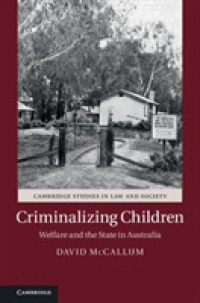- ホーム
- > 洋書
- > 英文書
- > Family / Marriage
Full Description
The birth of an infant sibling is a common occurrence in the lives of many toddler and preschool children. The current study examined individual differences in trajectories of young children's behavioral and emotional adjustment after the birth of a sibling. Growth mixture modeling (GMM) was conducted with a sample of 241 families expecting their second child using a longitudinal research design across the first year after the sibling's birth (prenatal, 1, 4, 8, and 12 months) on seven syndrome scales of the Child Behavior Checklist. Multiple classes describing different trajectory patterns of adjustment and adaptation emerged. There was no evidence of a persistent maladaptive response indicating children undergo a developmental crisis after the birth of a sibling. Most children were low on all problem behaviors examined and showed little change, although some children did experience more pronounced changes in the borderline or clinical range. There was an Adjustment and Adaptation Response for aggressive behavior, indicating that some young children react to stressful life events but adapt quickly. Data mining procedures uncovered various child, parent, and family variables that discriminated different trajectory classes. Children's temperament, coparenting, parental self-effi cacy, and parent—child attachment relationships were prominent in predicting children's adjustment after the birth of an infant sibling. When trajectory classes were used to predict sibling relationship quality at 12 months, children high on aggression, attention problems, and emotional reactivity engaged in more conflict and less positive involvement with the infant sibling at the end of the first year.
Contents
I. INTRODUCTION: UNDERSTANDING THE TRANSITION TO SIBLINGHOOD FROM A DEVELOPMENTAL PSYCHOPATHOLOGY AND ECOLOGICAL SYSTEMS PERSPECTIVE 7
Brenda L. Volling
II. METHODS AND PROCEDURES FOR THE FAMILY TRANSITIONS STUDY FROM A DEVELOPMENTAL PSYCHOPATHOLOGY AND ECOLOGICAL SYSTEMS PERSPECTIVE 26
Wonjung Oh, Brenda L.Volling, Richard Gonzalez, Lauren Rosenberg, and Ju-Hyun Song
III. STABILITY AND CHANGE IN CHILDREN'S EMOTIONAL AND BEHAVIORAL ADJUSTMENT AFTER THE BIRTH OF A SIBLING 46
Brenda L. Volling,Wonjung Oh, and Richard Gonzalez
IV. DEVELOPMENTAL TRAJECTORIES OF CHILDREN'S AGGRESSIVE BEHAVIORS AFTER THE BIRTH OF A SIBLING 53
Brenda L.Volling, Richard Gonzalez,Tianyi Yu, and Wonjung Oh
V. DEVELOPMENTAL TRAJECTORIES OF CHILDREN'S ATTENTION PROBLEMS AFTER THE BIRTH OF A SIBLING 72
Ju-Hyun Song,Wonjung Oh, Richard Gonzalez, Brenda L.Volling, and Tianyi Yu
VI. DEVELOPMENTAL TRAJECTORIES OF CHILDREN'S ANXIETY AND DEPRESSION AFTER THE BIRTH OF A SIBLING 82
Elizabeth Thomason,Wonjung Oh, Brenda L.Volling, Richard Gonzalez, and Tianyi Yu
VII. DEVELOPMENTAL TRAJECTORIES OF CHILDREN'S EMOTIONAL REACTIVITY AFTER THE BIRTH OF A SIBLING 93
Patty X. Kuo, Brenda L.Volling, Richard Gonzalez,Wonjung Oh, and Tianyi Yu
VIII. DEVELOPMENTAL TRAJECTORIES OF CHILDREN'S WITHDRAWAL AFTER THE BIRTH OF A SIBLING 106
Wonjung Oh, Ju-Hyun Song, Richard Gonzalez, Brenda L.Volling, and Tianyi Yu
IX. DEVELOPMENTAL TRAJECTORIES OF CHILDREN'S SOMATIC COMPLAINTS AFTER THE BIRTH OF A SIBLING 118
Emma Beyers-Carlson, Matthew M. Stevenson, Richard Gonzalez,Wonjung Oh, Brenda L.Volling, and Tianyi Yu
X. DEVELOPMENTAL TRAJECTORIES OF CHILDREN'S SLEEP PROBLEMS AFTER THE BIRTH OF A SIBLING 130
Paige Safyer, Matthew M. Stevenson, Richard Gonzalez, Brenda L.Volling, Wonjung Oh, and Tianyi Yu
XI. GENERAL DISCUSSION: CHILDREN'S ADJUSTMENT AND ADAPTATION FOLLOWING THE BIRTH OF A SIBLING 142
Brenda L.Volling
REFERENCES 159
ACKNOWLEDGMENTS 183
COMMENTARY
PREDICTING NORMATIVE AND PROBLEMATIC FAMILY PATHWAYS TO THE TRANSITION TO SIBLINGHOOD: COMMENTARY ON VOLLING ET AL.'S MONOGRAPH 184
Nina Howe
CONTRIBUTORS 196
STATEMENT OF EDITORIAL POLICY 199
SUBJECT INDEX 201








